
Nonprofit fundraising statistics reveal key trends in giving. This helps organizations understand donor behavior and optimize their campaigns. Key insights cover giving statistics, demographics, sector-specific donations, and matching gift programs. This information helps organizations make informed decisions and strengthen fundraising outcomes throughout the year.
How to use fundraising statistics to guide your strategy
Fundraising statistics show you who is giving, how much, and to which causes. Using these statistics to guide your search with donor prospect research software will help you pinpoint high-potential supporters and focus your outreach where it will have the greatest impact.
Key charitable giving statistics
The Lilly Family School of Philanthropy at Indiana University reported that the total US charitable giving reached $592.50 billion in 2024. That represents a 6.3% increase in nominal dollars (3.3% adjusted for inflation) over the prior year. This marks the first time in three years that charitable giving has outpaced inflation, bringing the sector back in line with long-term growth trends.
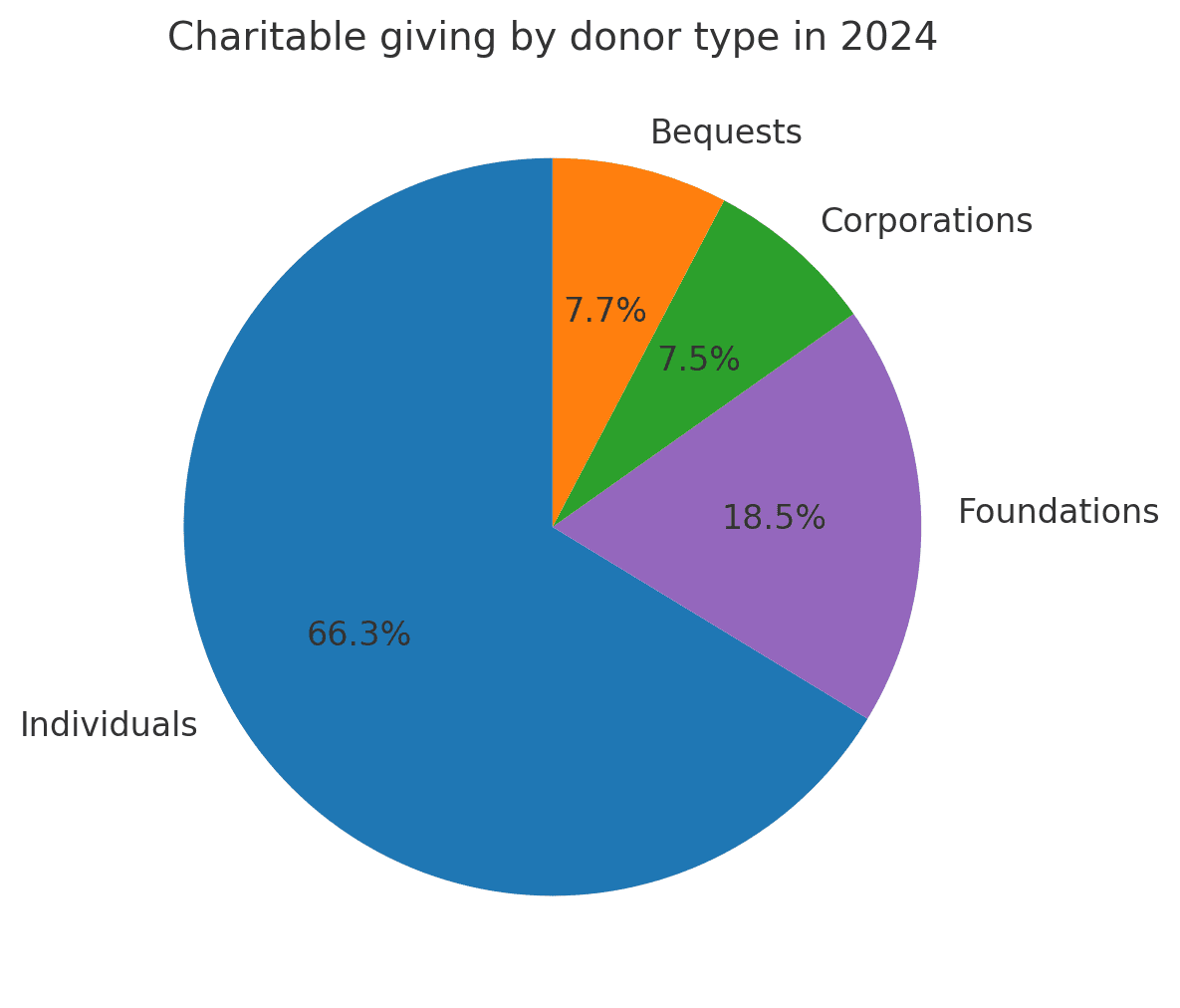
Individual giving
Individuals accounted for just over 66% of all charitable giving in 2024, contributing $392.45 billion (Lilly Family School of Philanthropy). An AP-NORC poll found that roughly 76% of U.S. adults donated financially over the past year, though most contributions were $500 or less. While individuals remain the largest source of nonprofit funding, the decline in participation from smaller donors presents a long-term challenge for sustaining broad-based giving.
Foundation giving
Foundation giving rose by 2.4% in 2024, bringing the total to $109.81 billion (Lilly Family School of Philanthropy). While this increase kept grantmaking above the $100 billion mark for the third year running, inflation-adjusted numbers were essentially flat. This shows that real growth in this category remains limited.
Unlock the secrets to foundation research.
Learn how to identify top foundational donors, analyze giving patterns, and prioritize prospects with actionable insights.
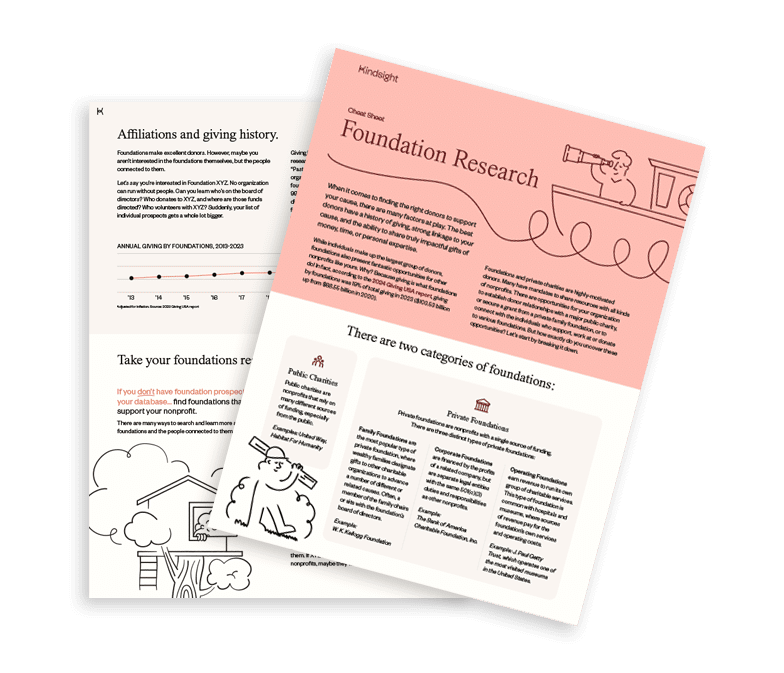
Corporation giving
Corporations gave a total of $44.40 billion in 2024, marking a 9.1% rise over the previous year (Lilly Family School of Philanthropy). Economic growth and higher pre-tax profits helped to drive this record-breaking level of corporate philanthropy. It’s the highest ever measured in both nominal and inflation-adjusted terms.
Bequests
Bequests totaled $45.84 billion in 2024, accounting for roughly 7.7% of all charitable giving (Lilly Family School of Philanthropy). This was a modest decline of 1.6% (4.4% adjusted for inflation) from 2023. Despite the drop, bequests continue to provide a reliable source of long-term support for nonprofits.
Demographic fundraising statistics
Demographic trends reveal both stability and change in donor behavior. They’re key to creating an ideal donor profile, helping your fundraising team target the right audience.
Age
Age plays an important role in charitable behavior, influencing both how much people give and the ways they contribute. Understanding generational trends helps your nonprofit tailor its fundraising strategies to engage each group effectively.
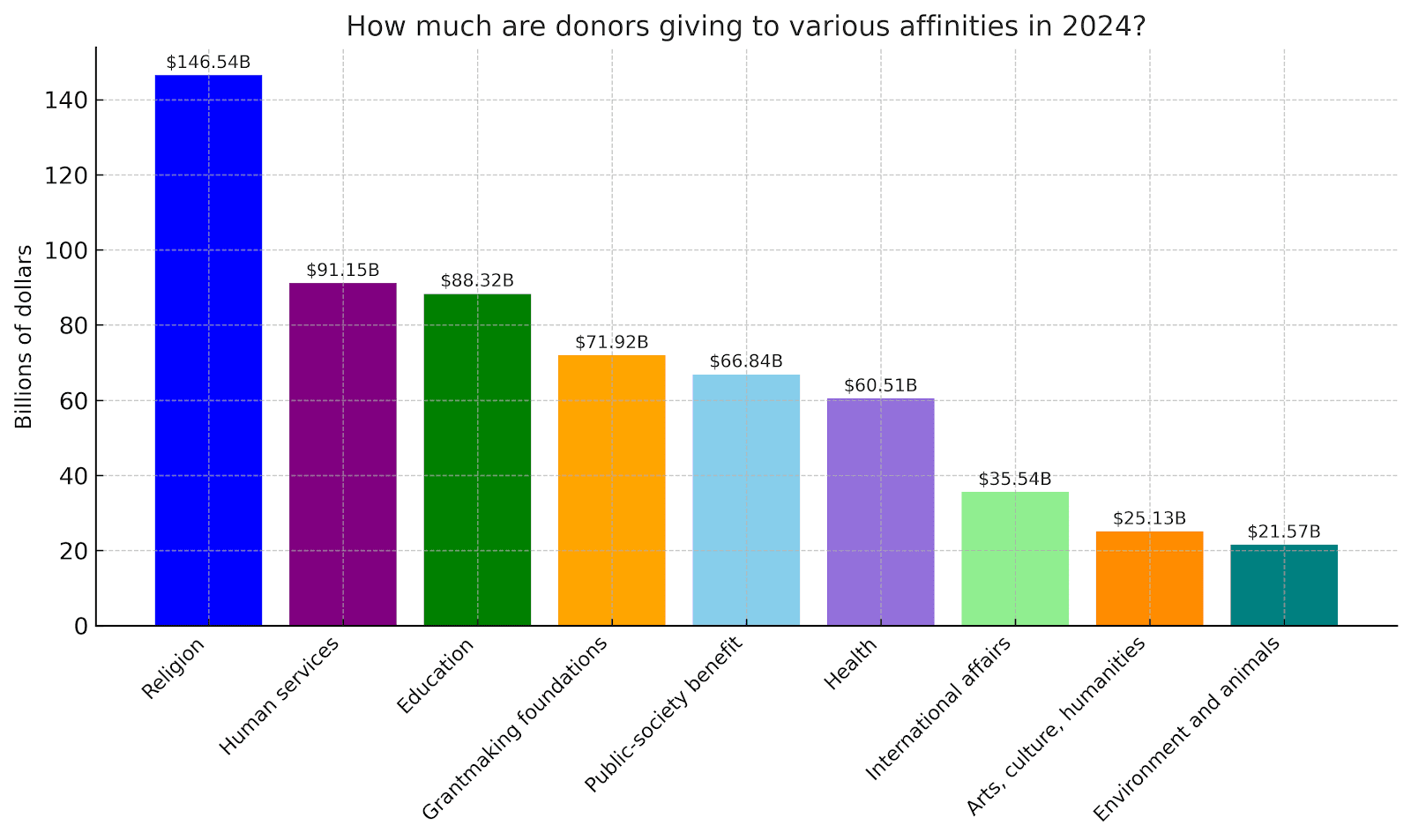
Gen Z
Gen Z (born 1997–2012) makes up 20.8% of the U.S. population in 2024, with about 70.8 million individuals. They’re the youngest donor group, but their influence is growing quickly. In 2023, Gen Z donors gave an average of $785 annually, despite having an average income of just $38,635.
Gen Z is motivated by social causes and shaped by peer networks and digital culture. They tend to give through crowdfunding sites, social media drives, or mobile apps rather than traditional methods. Many also support nonprofits through recurring micro-donations linked to payment platforms.
Gen Zers usually focus on causes that align with social impact and activism, including:
- Social justice and human rights
- Environmental and climate action organizations
- Animal welfare
- Health and medical causes
- Education and youth-focused programs
Gen Z prefers short, visual, and interactive communication instead of phone calls or long emails. Nonprofits will engage this group by being authentic and transparent while showing how their work creates real-world impact.
Millennials
Millennials (born 1981–1996) made up 21.8% (74.2 million) of the US population in 2024, with the oldest members now well into their forties (Marketing Charts). They remain a vital donor group: 84% give to charity, averaging $481 annually across 3.3 organizations in 2023. Many also commit through recurring programs, with 40% enrolled in monthly giving.
Millennial households earn an average salary of $84,975 (BLS.gov), yet many still struggle with student debt, high housing costs, and stagnant wages. They represent the largest share of US renters and have more households in poverty than any other generation.
Millennials concentrate their giving on:
- Children’s charities
- Health and medical nonprofits
- Local religious institutions
- Human rights or international aid groups
Their charitable actions are shaped by social influence and digital connection, while traditional outreach like phone calls or email is less effective. Many give through social media campaigns, peer fundraising, or workplace programs. To engage them effectively, nonprofits should lean into digital outreach and align with causes that match Millennial values and social awareness.
Gen X
Gen X (born 1965–1980) makes up 19.3% of the U.S. population, with roughly 65.6 million individuals in 2024 (Marketing Charts). They account for 22% of total charitable giving in the US and lead all generations in annual volunteer hours served.
In 2023, Gen X donors gave an average of $732 annually across nearly four charities (BridgeWorks). Nearly half participate in recurring giving programs, highlighting their commitment to ongoing support.
This generation is often in a “sandwich” phase of life, balancing their careers, children, and aging parents. Their average household income is $113,445 (BLS.gov), but many carry higher debt loads than other generations, averaging $136,000.
Gen Xers typically donate to:
- Animal organizations
- Local social and human services organizations
- Local religious groups
- Children’s charities
Gen X responds well to digital and voice outreach, including text messaging, email, and social media. Nonprofits will engage this group effectively by combining straightforward digital campaigns with personalized communications that acknowledge their busy, multi-role lifestyles.
Want to dig deeper into Gen X?
Learn what drives donor trust and gain awareness of Gen X’s giving behaviors, attitudes, and values so that you can create more informed strategies.
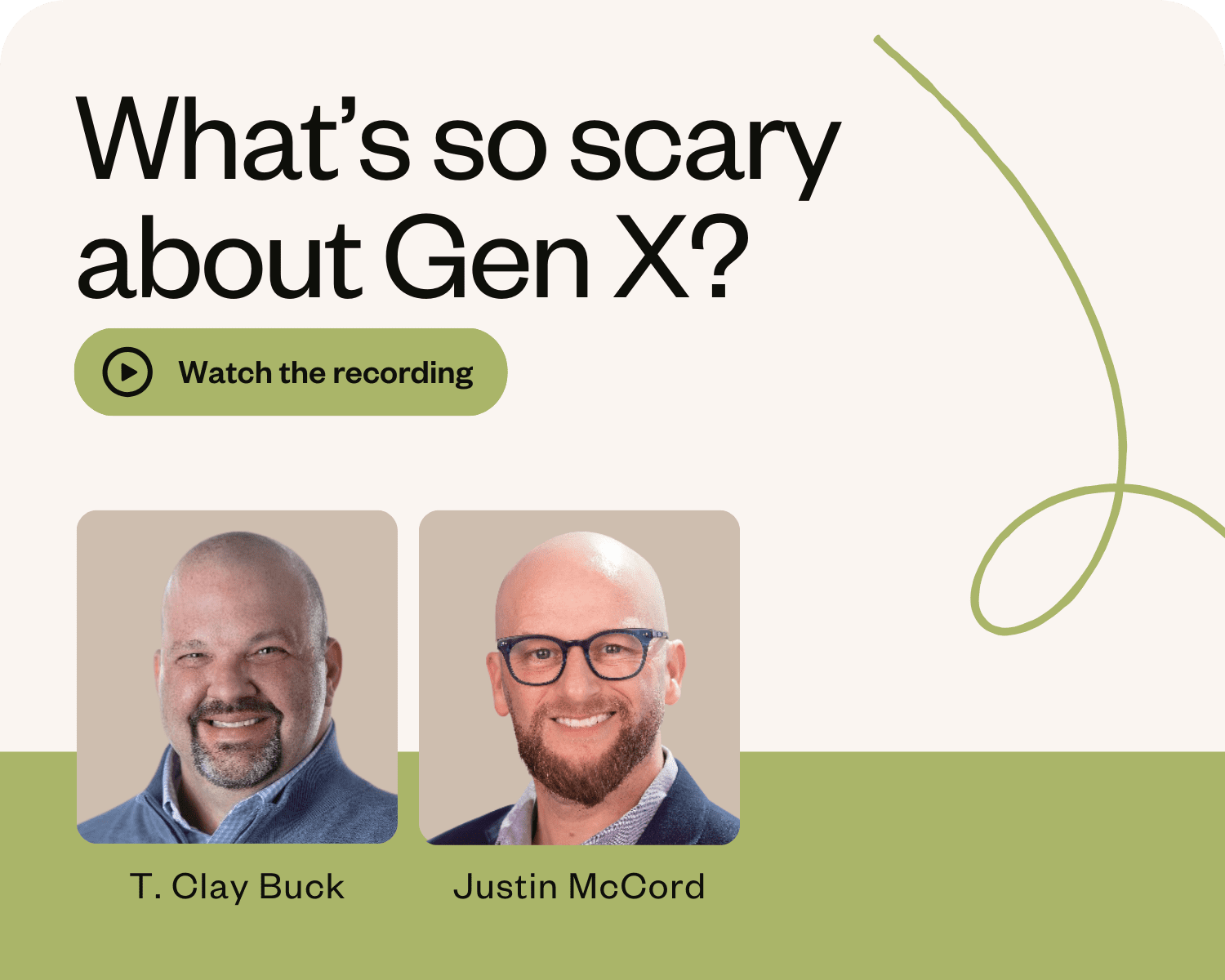
Baby Boomers
Baby Boomers (born 1946–1964) make up 19.7% of the U.S. population, with 66.9 million individuals in 2024 (Marketing Charts). They’re highly engaged locally, with 71% volunteering in their communities.
They’re the most generous donor group, accounting for 43% of total charitable giving nationwide. In 2023, 72% of Boomers gave to charity, contributing an average of $1,212 annually across 4.5 organizations (BridgeWorks).
Many Boomers are in or nearing retirement, with 66.9% of those aged 65–74 no longer in the workforce. Over 4.1 million Baby Boomers will reach retirement age each year between 2024 and 2027. The average Boomer household income is around $78,508 (BLS.gov), but their financial stability varies depending on retirement savings and healthcare costs.
Baby Boomers are big supporters of:
- Animal organizations
- Children’s charities
- Local places of worship
- Local social services
- Human rights and international affairs
Boomers are the most likely to attend fundraising events and remain highly responsive to personal outreach, such as phone calls and text messages. Digital platforms actually do matter, with 82% of Boomers maintaining at least one social media profile. This makes a multi-channel approach the most effective way to connect with them.
Silent Generation
The Silent Generation (born 1928–1945) makes up 4.4% of the US population in 2024, with about 15.1 million individuals (Marketing Charts). Though the smallest group by size, they remain deeply committed to philanthropy. Silent Generation donors gave an average of $1,367 to 6.2 organizations in 2023 (BridgeWorks), the highest of any generation, even though their average income was $41,876 (BLS.gov).
Most are fully retired and living on fixed incomes. Even so, they continue to prioritize charitable giving, often supporting community causes. Their giving reflects long-standing loyalty, with many maintaining ties to the same nonprofits for decades.
The Silent Generation tends to support:
- Veterans’ causes
- Emergency and disaster relief
- Local religious groups
- Local social services
The Silent Generation prefers traditional communication methods such as direct mail and phone calls, though some have adopted email for convenience. To engage them effectively, nonprofits should emphasize personal connection, trust, and a clear demonstration of impact.
Income level
The Tax Policy Center’s 2020 data shows how charitable giving patterns vary by income group.
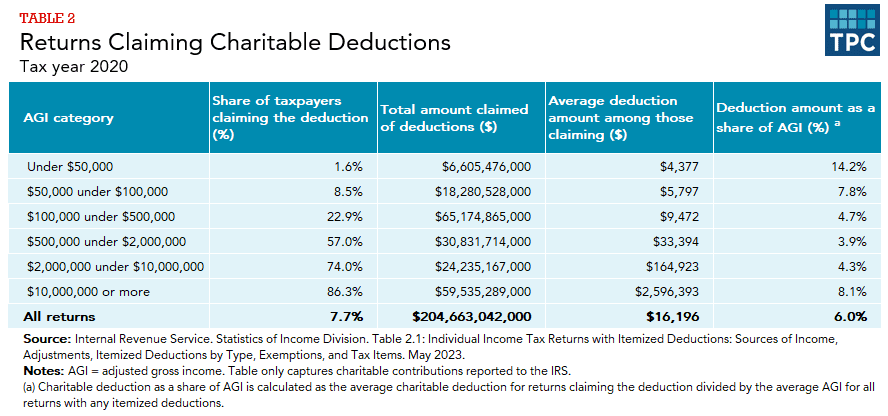
Points that stand out:
- Households earning under $50,000 gave the highest share of their income at 14.2%.
- Those with incomes between $500,000 and $2 million gave the lowest share, 3.9%.
- The wealthiest households (incomes over $10 million) donated nearly $2.6 million on average, equal to 8.1% of their income.
Overall, lower-income households give a larger share of what they earn, while higher-income households contribute more in total dollars but a smaller percentage of their income.
Location
WalletHub ranks US states on overall generosity, factoring in both charitable donations and volunteer hours. Some states give more money but volunteer less, which affects their overall ranking. For example, New York ranks 13th overall in charitable giving, placing 39th for volunteering and 1st for charitable donations.
Generosity isn’t just about dollars; it also includes time and community engagement. These are the top 18 results from WalletHub:
|
Overall Rank* |
State |
Total Score |
Volunteering & Service Rank |
Charitable Giving Rank |
|
1 |
Wyoming |
75.30 |
1 |
7 |
|
2 |
Utah |
73.83 |
3 |
4 |
|
3 |
Minnesota |
71.80 |
5 |
5 |
|
4 |
Maine |
69.64 |
2 |
26 |
|
5 |
Delaware |
65.93 |
7 |
16 |
|
6 |
Maryland |
65.66 |
19 |
2 |
|
7 |
Oregon |
64.23 |
6 |
28 |
|
8 |
Colorado |
63.33 |
14 |
12 |
|
9 |
Pennsylvania |
63.31 |
10 |
15 |
|
10 |
Nebraska |
63.17 |
4 |
41 |
|
11 |
Virginia |
62.73 |
30 |
3 |
|
12 |
Illinois |
62.57 |
21 |
9 |
|
13 |
New York |
61.34 |
39 |
1 |
|
14 |
Iowa |
60.45 |
16 |
19 |
|
15 |
North Dakota |
60.32 |
18 |
17 |
|
16 |
Ohio |
60.18 |
13 |
23 |
|
17 |
Kansas |
59.94 |
17 |
23 |
|
18 |
Missouri |
59.31 |
22 |
20 |
Canada
Manitoba led the provinces in 2022, with 19.3% of tax filers donating and 0.71% of aggregate income given to charity. Quebec donated the lowest percentage of income at 0.26%. New Brunswick had the smallest share of donors at 14.7%.
Canadian giving has declined over the past decade. The share of tax filers donating fell from 22.4% in 2012 to 17.1% in 2022, and the percentage of income donated dropped from 0.55% to 0.50% (Fraser Institute). This decline limits the ability of Canadian charities to support communities and improve the quality of life.
This table shows the percentage of Canadian residents who donated in 2024 and each city’s change in ranking compared with 2023.
|
2024 Rank |
City |
Province |
% of Residents Donating |
2023 Rank |
|
1 |
Centre Wellington |
Ontario |
6.27% |
1 |
|
2 |
Collingwood |
Ontario |
5.6% |
2 |
|
3 |
Fort Erie |
Ontario |
5.27% |
4 |
|
4 |
North Vancouver |
British Columbia |
4.62% |
6 |
|
5 |
Victoria |
British Columbia |
4.58% |
7 |
|
6 |
Fredericton |
New Brunswick |
4.25% |
8 |
|
7 |
St. John’s |
Newfoundland & Labrador |
4.23% |
3 |
|
8 |
Whitehorse |
Yukon |
4.10% |
5 |
|
9 |
Waterloo |
Ontario |
4.07% |
9 |
|
10 |
Brant |
Ontario |
3.94% |
11 |
Matching gifts fundraising statistics
With corporate social responsibility (CSR) initiatives making headlines, the American Society of Employers reports that 51% of Russell 1000 companies and 65% of Fortune 500 companies publicly offer matching gift programs. Despite this, only 1.31% of eligible individual donations are matched, leaving billions in unclaimed potential.
Matching campaigns should matter to nonprofit organizations! 84% of donors are more likely to give when a match is offered, driving higher response rates and larger gifts.
Corporations generally support nonprofits that improve the local community and align with employee interests. Matching programs now make up nearly 11% of corporate giving, approximately $2.86 billion annually.
GivingTuesday 2024 statistics
The GivingTuesday Data Commons estimates Americans donated $3.6 billion in a single day, a 16% increase from 2023’s $3.1 billion. This brought the total contributed since the event launched in 2012 to more than $18.5 billion. Participation reached record levels, with 36.1 million people in the US taking action, alongside countless acts of giving around the world.
The ways people gave were diverse:
- 18.5 million people made financial contributions (+4% vs 2023)
- 12.9 million donated goods (+32%)
- 9.2 million volunteered their time (+4%)
- 16.6 million spoke out about causes (+17%).
These results show GivingTuesday is as much about community connection and advocacy as it is about dollars raised.
Charitable giving by sector
Charitable donations in the US flow into a variety of sectors, from education and religion to health and the arts. Sector-level data shows how priorities are shifting and where nonprofits have the greatest room to grow.
Religious institutions and human service nonprofits addressing basic needs like food and shelter remain the main beneficiaries of charitable giving. This reflects widespread donor focus on community support and essential services.
The following table and chart highlight how donations were distributed across major sectors in 2024. They give a clear view of where Americans directed their generosity during the year, with human services, education, and religion standing out as leading categories.
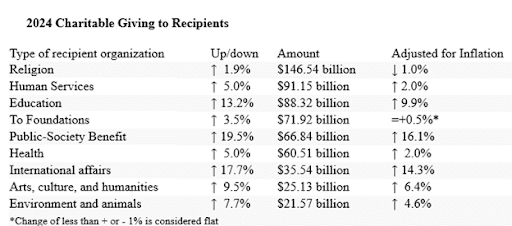
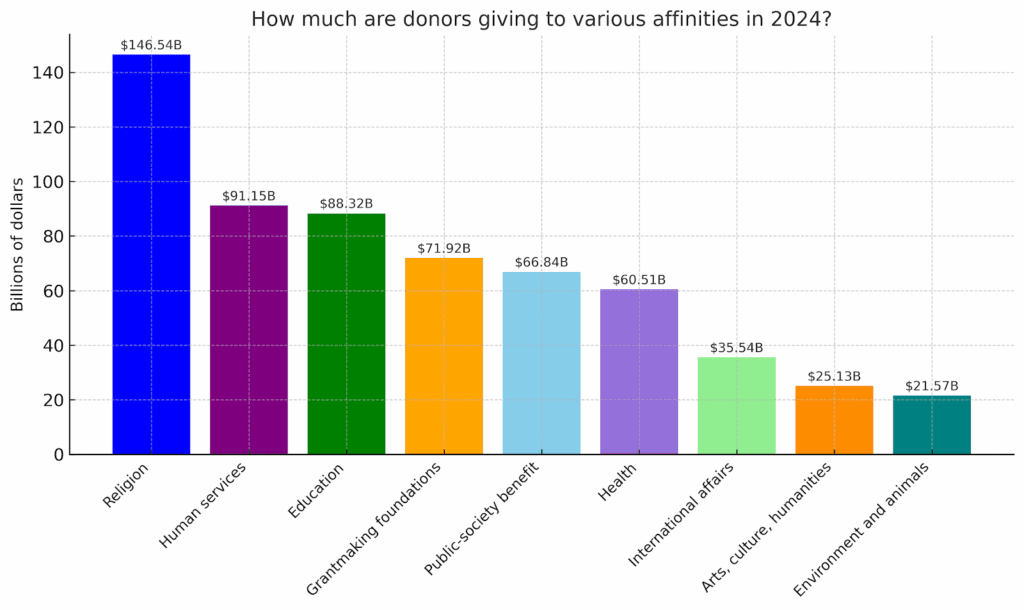
Education and school-based fundraising statistics
In 2024, education nonprofits received an all-time high of $88.32 billion. That was a 13.2% increase from the previous year, or 9.9% after adjusting for inflation. Higher education made up $61.5 billion of that total, marking a 3% year-over-year gain.
The previous charts show education landing among the top three in 2024. This places it just behind the nation’s leading cause area, underscoring education’s ongoing importance in philanthropy.
Religious and faith-based fundraising statistics
Giving to religion totaled $146.5 billion in 2024, a 1.9% increase from the previous year, though it declined by 1.0% after adjusting for inflation. Religion now accounts for just 23% of total giving, down from 34% in 2011 and 24% in 2023 (Lake Institute). This shift reflects broader societal changes: fewer Americans identify as religious, and congregational giving is weakening.
Despite these trends, faith-driven philanthropy remains powerful. A recent AP-NORC poll found that 37% of Americans gave to religious institutions in the past year, just behind those who donated to food and shelter causes.
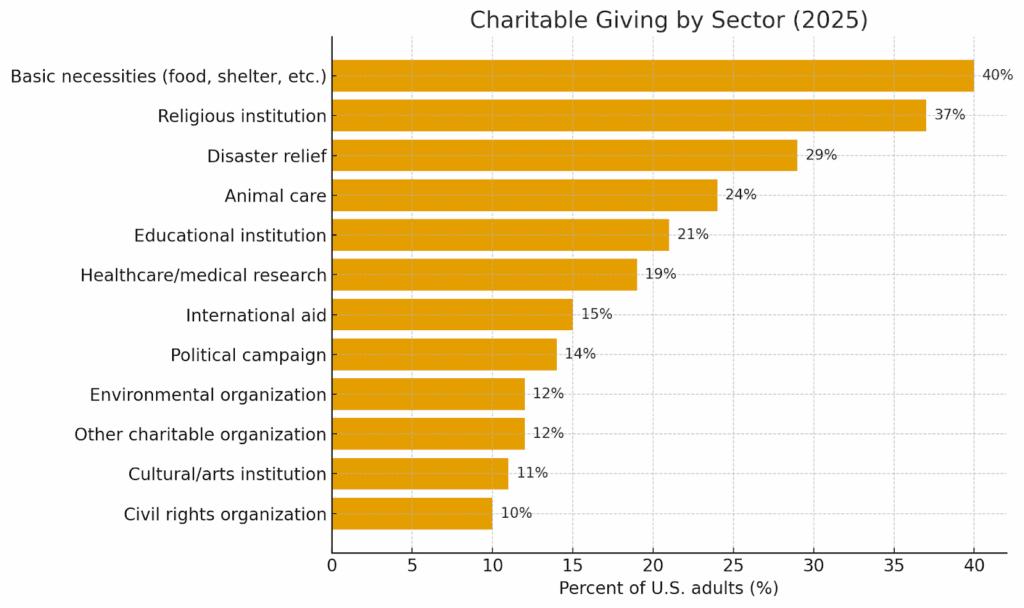
About the data: Results are based on interviews with 1,229 U.S. adults that were conducted March 20-24, 2025. The margin of error is ±3.9 percentage points for the full sample.
Source: Associated Press-NORC Center for Public Affairs Research
Regular tithing is uncommon, with only about 5% of churchgoers giving consistently. Half of those who donate contribute roughly 2% of their income, while 37% of regular attendees give nothing to their own church (ChurchTrac). Despite this, many still support other religious organizations or causes.
Religious giving also varies by faith. Jewish donors give the most, averaging $2,526 annually, followed by Protestants ($1,749), Muslims ($1,178), and Catholics ($1,142). Jewish and Muslim donors are more likely to support social and human rights causes, while Christian giving patterns differ by denomination.
Giving trends over time
Charitable giving has grown steadily since 1995. The graph below shows how donations from individuals, foundations, and corporations have changed over time, highlighting peaks, dips, and long-term trends.
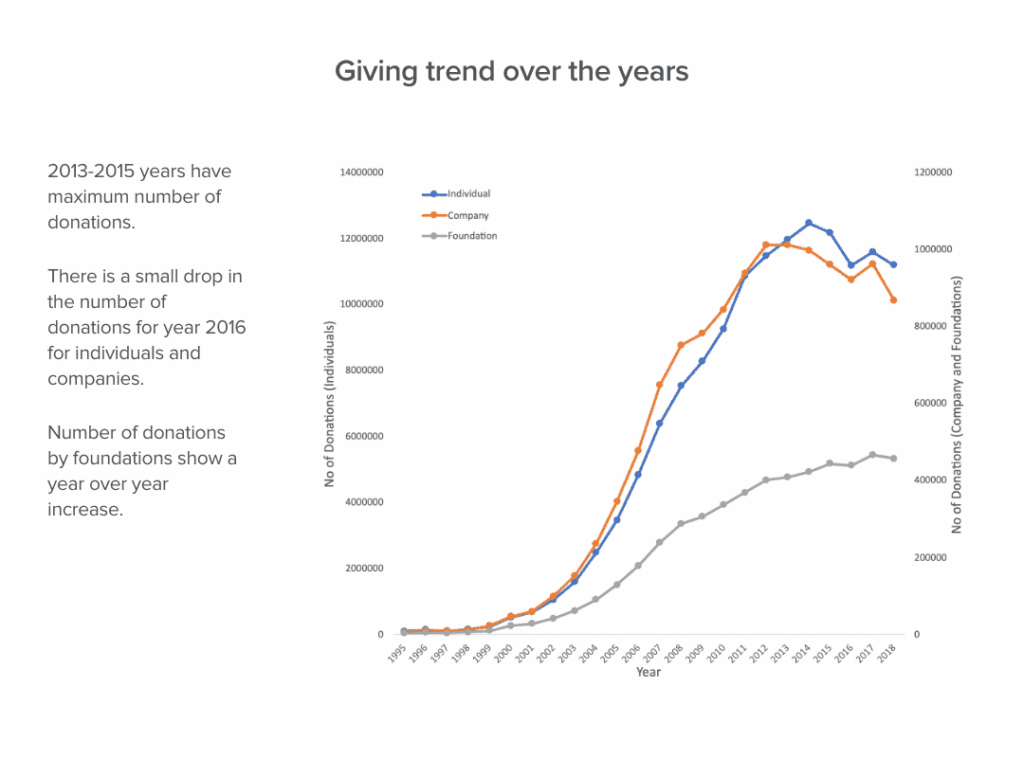
Fundraising trends in 2025
In 2025, nonprofit fundraising is being shaped by shifting donor behaviors and policy changes. Understanding these trends will help your nonprofit adapt its strategies and sustain support.
Giving and donor counts
Fundraising dollars are growing, but donor numbers are declining. In Q1 2025, total dollars raised increased 3.6% year over year, according to the Fundraising Effectiveness Project. At the same time, the number of donors fell 1.3%, showing ongoing challenges in expanding the donor base.
Retention also remains weak. The average retention rate slipped from 18.3% in 2024 to 18.1% in Q1 2025. This means nonprofits are raising more from fewer donors, but long-term sustainability depends on reversing those declines in participation and loyalty.
Policy Impact: Universal charitable deduction
The 2025 One Big Beautiful Bill (OBBB) introduced a universal charitable deduction that takes effect in 2026. Taxpayers who don’t itemize will be able to deduct up to $1,000 individually or $2,000 for joint filers. This change is expected to expand small and mid-level giving, with some estimates projecting $74 billion in additional donations over the next decade.
The impact, however, is mixed. While the deduction will potentially grow donor participation, the OBBB also includes provisions that place new pressures on nonprofits. Analysts caution it’s likely to create a greater need for nonprofit services during that same donor expansion period.
Turning fundraising statistics into action
Nonprofit fundraising relies on understanding where support comes from and how donors behave. Individual giving, foundation and corporate contributions, bequests, and demographic trends all shape the overall fundraising landscape. Sector-specific data and matching gift programs provide additional opportunities to optimize strategy and increase impact.
By tracking these trends, nonprofits will focus their campaigns more effectively and engage donors with relevant messaging. Insights from charitable giving statistics help organizations plan initiatives, identify high-potential supporters, tailor outreach strategies, and track outcomes across campaigns. Using this data will ensure your fundraising efforts are informed, strategic, and positioned for success.
Be the first to read our resources.
The world is changing quickly—and our resources help you stay on top of it all. Sign up to get new insights, success stories, and more, sent right to your inbox.




